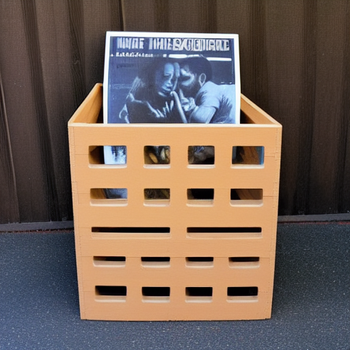The Best Guide to Vinyl Record Storage
Find out how to store your vinyl records properly so that you'll be able to play them on your turntable for years.
Updated October 2022

Are you a collector? Do you have a large collection of records that you want to make sure are properly stored and protected? Or maybe you've just bought a rare, vintage vinyl record and you want to make sure it stays in good condition. If so, then this guide is for you!
Not only vinyl provides a warm, rich sound, but they also offer a tangible connection to the artist and the era in which the music was created. However, discs are delicate and can be easily damaged. That's why record storage is so important.
Improper storage or using the wrong furniture can lead to warping, cracking, and other damage that can ruin your albums. But how to store them? In this post, we will discuss the best ways to store your vinyl so that you can play them on your turntable for years to come. Keep reading to learn more!
Storing records the correct way
Let's start from the beginning. You should clean your vinyl records before storing them. Over time, dust and other debris can build up on the surface of a record, which will cause issues down the road. Even when storing them properly. Fortunately, cleaning your records is a simple process that can be done quickly and only requires a few household supplies.
Once your record is clean, you can store it by keeping it upright in a vertical position. This is the key to storing them correctly. By doing so, you decrease the pressure from other records if stored horizontally.
Although one record is not exceedingly heavy, 20 or more records create a considerable weight that can cause warping to records at the bottom. If you need to stack them, always start with the heaviest one on the bottom and work your way up. But never add more than 5 in the same pile.
The location is also important. Here are some tips for choosing where to store them:
-
Store your records in a cool, dry place.
-
Minimize exposure to sunlight or heat as it can cause warp, which can lead to damage that can only be repaired with a flattener machine.
-
Keep your records away from direct sources of humidity, such as humidifiers and air conditioners.
Finally, inspect your records regularly for signs of wear and tear. If you suspect any damage, you can verify whether they are warped.

The best storage shelf, cabinet, and other furniture
Now that we know how to store vinyl records, it's time to talk about the best furniture for storing them. Ideally, you want something that is specifically designed for storing records. This way, you can be sure that your discs are properly protected and won't be damaged.
When it comes to choosing the right storage shelf or cabinet, there are a few things you need to keep in mind:
-
Size: Make sure you choose a shelf or cabinet that is large enough to accommodate your entire collection. You don't want to have to stack your records on top of each other as this can lead to warping and other damage.
-
Weight capacity: Another important factor to consider is weight capacity. As we mentioned before, one record is not too heavy, but a stack of them can be. That's why it's important to choose a storage unit that can handle the weight of your entire collection.
-
Material: The material is also important as you want something that is durable and won't absorb moisture. A good option is wood, but make sure it is unfinished as this will prevent warping. Metal is another good choice as it is also durable and won't absorb moisture.
In addition to a storage shelf or cabinet, there are a few other pieces of furniture that can be used to store records. Record crates or boxes are popular for storing records and are a great option if you have a large collection. They come in a variety of sizes and can be stacked on top of each other to save space. Sideboards are another piece of furniture that can be used to store records. They typically have shelves or drawers that can be used to organize your collection.
DIY vinyl record storage ideas and Ikea hacks
If you're looking for a more budget-friendly option, there are a few DIY storage ideas that you can use. One popular option is to repurpose an old dresser or cabinet into a storage unit for your records. This is a great way to save money and get a unique piece of furniture for your home.
If you don't have any old furniture that you can repurpose, another option is to build your storage shelf or cabinet. This is a more involved project, but it's doable if you're handy. There are plenty of plans and tutorials available online that will walk you through the process step-by-step.
If you're not interested in building something from scratch, another option is to hack a piece of Ikea furniture. This is a popular option as Ikea furniture is relatively inexpensive and easy to hack. There are tons of different ideas out there, so you're sure to find something that will work for your space and needs.

That's it! By following these steps, you can help ensure that your records will arrive safely and undamaged at their destination. However, if you suspect there might be some damage or your record sounds weird, check out this post on how to tell if your record is warped.
Shipping vinyl records doesn't have to be difficult, and by taking some extra care in the packing process, you can rest assured knowing that your records will arrive in the same condition as when they left.



